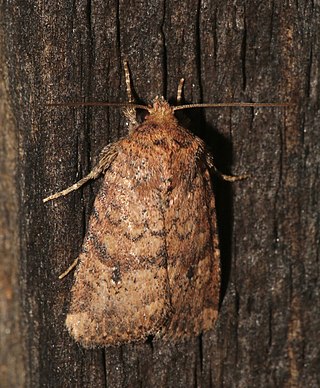Homolagoa is a monotypic moth genus of the family Noctuidae. Its only species, Homolagoa grotelliformis, is found in North America. Both the genus and species were first described by William Barnes and James Halliday McDunnough in 1912.
Hyperepia is a monotypic moth genus of the family Noctuidae erected by William Barnes and Arthur Ward Lindsey in 1922. Its only species, Hyperepia jugifera, was first described by Harrison Gray Dyar Jr. in 1920. It is found in North America.
Phytometra apicata is a moth in the family Erebidae described by William Barnes and James Halliday McDunnough in 1916. It is found in North America.

Homorthodes furfurata, the northern scurfy Quaker moth or scurfy Quaker moth, is a species of moth in the family Noctuidae . It was described by Augustus Radcliffe Grote in 1874 and is found in forest habitats in North America. Its range extends across the continent, to south-eastern Canada, Massachusetts, New York, and Mississippi. In the west it ranges south to California, Arizona, New Mexico and Texas.

Properigea niveirena is a species of moth in the family Noctuidae. It was described by Leon F. Harvey in 1876 and is found in North America, where it ranges from Vancouver Island, through western British Columbia, Washington and Oregon south to California and the border with Mexico, then east to New Mexico through southern Arizona.
Lacinipolia incurva is a species of moth in the family Noctuidae. It was described by John B. Smith in 1888 and is found in North America, where it has been recorded from California, Arizona, New Mexico, Texas, Utah and Colorado.
Parabagrotis insularis is a species of moth in the family Noctuidae. It is found in North America, where it has been recorded from southern Vancouver Island, along the Pacific Coast through California to near the border with Mexico. The species was described by Augustus Radcliffe Grote in 1876.
Xestia verniloides is a species of cutworm or dart moth in the family Noctuidae. It was described by J. Donald Lafontaine in 1998 and is found in North America.
Pseudeustrotia indeterminata is a species of cutworm or dart moth in the family Noctuidae. It was described by William Barnes and James Halliday McDunnough in 1918 and is found in North America.
Heterocampa averna is a species of prominent moth in the family Notodontidae. It was described by William Barnes and James Halliday McDunnough in 1910 and is found in North America.

Datana perspicua, the spotted datana, is a species of prominent moth in the family Notodontidae. It was described by Augustus Radcliffe Grote and Coleman Townsend Robinson in 1865 and is found in North America.
Lineostriastiria hachita is a moth in the family Noctuidae. It was described by William Barnes in 1904 and is found in North America.
Dichagyris neoclivis is a species of cutworm or dart moth in the family Noctuidae. It was described by William Barnes and Foster Hendrickson Benjamin in 1924 and is found in North America.
Eulithosia papago is a species of moth in the family Noctuidae. It was first described by William Barnes in 1907 and it is found in North America.
Heterocampa amanda is a species of moth in the family Notodontidae. It was first described by William Barnes and Arthur Ward Lindsey in 1921 and it is found in North America.
Meganola fuscula is a species of nolid moth in the family Nolidae. It is found in North America.

Meganola spodia, commonly known as the ashy meganola or Franclemont's meganola moth, is a species of nolid moth in the family Nolidae. It is found in North America.
Sympistis deceptiva is a species of moth in the family Noctuidae. It was first described by William Barnes and Arthur Ward Lindsey in 1922 and it is found in North America.

Meganola minuscula, the confused meganola, is a nolid moth. The species was first described by Philipp Christoph Zeller in 1872. It is found in North America.
Meganola conspicua, the conspicuous meganola moth, is a species of nolid moth in the family Nolidae. It is found in North America.




